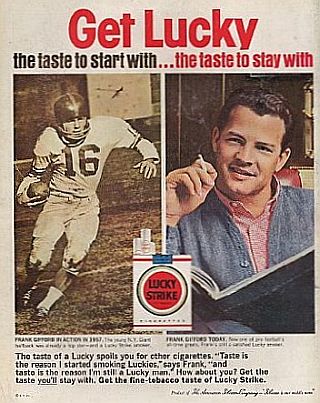
Frank Gifford, football star for the New York Giants, appeared in Lucky Strike cigarette ads in the early 1960s, including this one, which appeared on the back cover of ‘The Saturday Evening Post’ magazine, November 10, 1962.
Born in Santa Monica, California in 1930, Gifford graduated from Bakersfield High School, became a Junior College All- American football player at Bakersfield College, then proceeded to the University of Southern California where he also became an All-American. He entered the profes- sional ranks in 1952, joining the New York Giants, where he played his entire career.
Gifford began his career with the Giants playing both offense and defense, a rarity at a time when platoon football had begun following World War II. He made eight Pro Bowl appearances and had five trips to the NFL Championship Game. Gifford’s biggest season may have been 1956, when he won the Most Valuable Player award of the NFL, and led the Giants to the NFL title over the Chicago Bears. Gifford also played in the famous December 1958 championship game between the New York Giants and the Baltimore Colts, a game that many believe ushered in the modern era of big time, television-hyped, pro football. Gifford, in fact, has co-written a recent book on that game, titled The Glory Game.
In the early 1960s, however, Frank Gifford was a hot commodity, and his endorsement was sought for an array of products, cigarettes among them. In the magazine ad above, Gifford is shown in a photo from his playing days and another at leisure off the field, lending his endorsement to American Tobacco Company’s Lucky Strike brand. The caption beneath the football photograph of Gifford reads: “Frank Gifford in action in 1957. The young New York Giants halfback was already a top star — and a Lucky Strike smoker.” The other photograph, with Gifford holding a cigarette while looking trough an opened book, says: “Frank Gifford today. Now one of pro football’s all-time greats, Frank’s still a satisfied Lucky smoker.” The wording at the bottom of the ad says:
“The taste of Luckies spoils you for other cigarettes. ‘Taste is the reason I started smoking Luckies,’ says Frank, ‘and taste is the reason I’m still a Lucky man. ‘ How about you? Get the taste you’ll stay with. Get the fine tobacco-taste of Lucky Strike.”
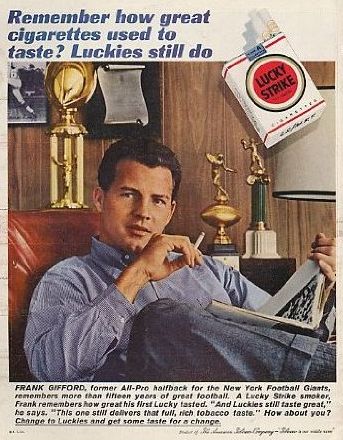
Frank Gifford, former New York Giants football star, appears in early 1960s magazine ad for Lucky Strike cigarettes.
“Taste Great”
In another early 1960s ad for Lucky Strike, Gifford is shown relaxing in a home den type setting with his football trophies behind him, cigarette in hand, as he lends his name to the Lucky Strike brand. The caption beneath his photo- graph reads:
“Frank Gifford, former All-Pro halfback for the New York Football Giants, remembers more than fifteen yeas of great football. A Lucky Strike smoker, Frank remembers how great his first Lucky tasted: ‘And Luckies still taste great,’ he says. ‘This one still delivers that full, rich tobacco taste.’ How about you? Change to Luckies and get some taste for a change.”
In addition to advertising for Lucky Strike cigarettes, Gifford, a popular sports figure in New York in the early 1960s, also did ads for other products including: Vitalis hair tonic, Jantzen swim wear, Dry Sack sherry, and Palmolive Rapid Shave.
In a 2013 interview by Mark Weinstein, Gifford was asked about his Lucky Strike cigarette ads. Here’s some of that exchange:
MW: “…And I’m wondering if, knowing what we now know about the adverse health effects of tobacco, you have any regrets about your association with Lucky Strike?”
FG: “I do, but only in the sense that when the Surgeon General’s report came out [January 1964], I very openly quit smoking. I quit the day the report came out. And that was the end of the advertising, too. I was making more doing that—potentially, anyway—than I was playing football. But that was the end of it. I said, ‘I’m not going to do it anymore.’ It’s been kind of lost in the pages of history, I guess, but that’s exactly what happened.”
Injury & Comeback
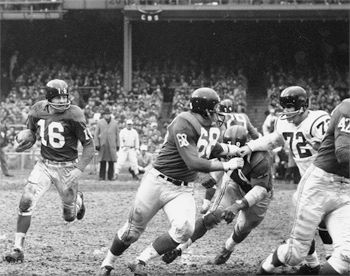
Frank Gifford (No. 16), New York Giants, running with ball against the Washington Redskins, Yankee Stadium, November 29, 1959. Photo, Neil Leifer.
In 12 seasons with the New York Giants, Gifford proved a versatile and valuable player. As a running back, he had 3,609 rushing yards and 34 touchdowns in 840 carries. As a receiver he had 367 receptions for 5,434 yards and 43 touchdowns. Gifford was also a halfback who could throw, and completed 29 of the 63 passes he attempted for 823 yards and 14 touchdowns. Gifford was also one of those rare players in the early modern era who played both offense and defense. In fact, during his career, he had Pro Bowl selections at three different positions — defensive back, running back, and wide receiver. Gifford was inducted into the Pro Football Hall of Fame on July 30, 1977, and in the year 2000, his New York Giants’ No. 16 playing numeral was formally retired.
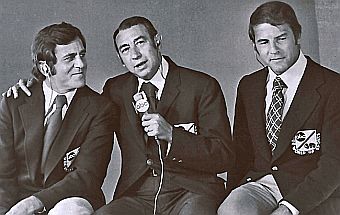
L-to-R, Don Meredith, Howard Cosell and Frank Gifford, the broadcast team for ABC-TV’s “Monday Night Football,” 1972.
After his playing days ended, Frank Gifford became a full-time sports broadcaster for NFL games on CBS radio and TV. By 1971 he became a play-by-play announcer on ABC’s Monday Night Football with Howard Cosell and Don Meredith — Meredith a former Dallas Cowboy football star. In 1995, Gifford was given the Pete Rozelle Award by the Pro Football Hall of Fame for his NFL television work. Gifford remained at Monday Night Football until 1998, when he left the show. He also appeared on other ABC sports programs, including Olympic Games coverage, ABC’s Wide World of Sports, various sports personality profiles. He also appeared as a guest on non-sports TV shows from time to time, including ABC-TV’s Good Morning America, where he met his third wife, Kathie Lee, a popular TV host. The two were married in 1986 and would have two children together. Throughout the late 1980s and the 1990s, millions of morning-TV viewers who watched ABC’s Live with Regis and Kathie Lee would often hear Kathie Lee Gifford’s descriptions of life at home with her sportscaster husband and their two children. Frank and Kathie Lee Gifford have also used their celebrity to raise money for charitable causes.
See also at this website, “Celebrity Gifford,” a longer story on the football, broadcasting, and celebrity history of Frank Gifford. Other stories on celebrity advertising at this website include, for example: Dennis Hopper pitching retirement planning for Ameriprise Financial, Madonna in a 1989 Pepsi ad, and John Wayne in 1950s’ Camel cigarette ads. Thanks for visiting — and if you like what you find here, please make a donation to help support the research and writing at this website. — Jack Doyle
|
Please Support Thank You |
_______________________________
Date Posted: 29 March 2010
Last Update: 15 February 2019
Comments to: jdoyle@pophistorydig.com
Article Citation:
Jack Doyle, “Gifford For Luckies, 1961-1962,”
PopHistoryDig.com, March 29, 2010.
_______________________________________
Sources, Links & Additional Information
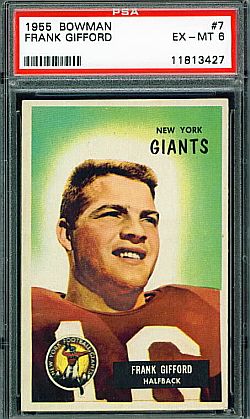
Frank Gifford football trading card from 1955 in protective case. Issued originally by Bowman Football Cards as #7 in a series, this card is graded and registered by PSA, Professional Sports Authenticator. “EX-MT” means the card is in “excellent-to-mint” condition, followed by a numerical grade. Click for 'very-good-to-excellent' card.
“Frank Gifford in TV Series,” New York Times, Thursday, January 21, 1960, p. 63.
William R. Conklin, “Star Back Signed by Radio Station; Gifford Retires as Player but Giants Hope to Keep Him in Advisory Post,” New York Times, Friday, February 10, 1961.
Robert M. Lipsytet, “Gifford Returns as a Player; Giants’ Halfback, 31, Gives Up Duties as Broadcaster; Back Holds 3 Club Records,” New York Times, Tuesday, April 3, 1962, Sports, p. 48.
“Pro Football May Seem Tame to Giant’s Gifford After Thrill of Making TV Ads,” Advertising Age 1963; 34(25): 64
Mike Puma, “Gifford Was Star in Backfield, Booth,” Sport Century Biography, ESPN Classics, ESPN.com.
Mike Puma, “Versatile Gifford Led the Giants,” ESPN.com, Wednesday, November 19, 2003.
Richard W. Pollay, “Promises, Promises : Self-Regulation of U.S. Cigarette Broadcast Advertising in The 1960s,” Tobacco Control 1994; 3: 134-144.
“Frank Gifford,” Wikipedia.org
Paul Wilkes, “Frank Gifford Talks a Good Game These Days,” New York Times, Sunday, December 14, 1969, p. D-27.
M. Jocelyn Elders, Preventing Tobacco Use Among Young People: A Report of the Surgeon General, 1994, Washington, D.C., U.S. Government Printing Office, 314pp.
“Kathie Lee Gifford,” Wikipedia.org.
Mark Weinstein, “Frank Gifford: Icon” (Interview with Gifford ), BlueNatic, Tuesday, August 20, 2013.
“History of the Surgeon General’s Reports on Smoking and Health,” CDC.gov.
____________________________